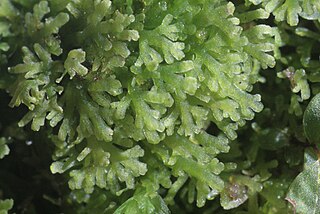
The Marchantiophyta are a division of non-vascular land plants commonly referred to as hepatics or liverworts. Like mosses and hornworts, they have a gametophyte-dominant life cycle, in which cells of the plant carry only a single set of genetic information.

Jungermanniales is the largest order of liverworts. They are distinctive among the liverworts for having thin leaf-like flaps on either side of the stem. Most other liverworts are thalloid, with no leaves. Due to their dorsiventral organization and scale-like, overlapping leaves, the Jungermanniales are sometimes called "scale-mosses".

Metzgeriales is an order of liverworts. The group is sometimes called the simple thalloid liverworts: "thalloid" because the members lack structures resembling stems or leaves, and "simple" because their tissues are thin and relatively undifferentiated. All species in the order have a small gametophyte stage and a smaller, relatively short-lived, spore-bearing stage. Although these plants are almost entirely restricted to regions with high humidity or readily available moisture, the group as a whole is widely distributed, and occurs on every continent except Antarctica.

Jungermanniopsida is the largest of three classes within the division Marchantiophyta (liverworts).

Aneuraceae is a family of thallose liverworts in the order Metzgeriales. Most species are very small with narrow, branching thalli.

Herbertaceae is a family of liverworts. The family consists of the genera Herbertus, Schisma and Triandrophyllum. The genus HerpocladiumMitten, 1873 was later merged into the genus Herbertus.

Blasiales is an order of liverworts with a single living family and two species. The order has traditionally been classified among the Metzgeriales, but molecular cladistics suggests a placement at the base of the Marchantiopsida.

Treubia is a genus of liverworts in the family Treubiaceae. There are seven species, all of which are restricted to the southern hemisphere. Five of the species occur in Australasia and the other occurs in Chile. All species are dioicous, with separate male and female gametophytes.
Cryptothallus is a previously recognized genus of liverworts in the family Aneuraceae. The plants are small, and are white to pale green as a result of lacking chlorophyll. This feature led to the creation of a separate genus. The morphology of species assigned to Cryptothallus is very similar to that of Aneura. As a result, Karen Renzaglia in 1982 suggested that the only species then placed in the genus, Cryptothallus mirabilis, may be considered "merely as an achlorophyllous species of Aneura." Wickett and Goffinet argued the same position on the basis of sequences of nuclear, mitochondrial, and plastid DNA, and moved Cryptothallus mirabilis to Aneura. A 2010 molecular phylogenetic study confirmed the position of Cryptothallus within Aneura. This was accepted in the 2016 world checklist of hornworts and liverworts.

Solenostomataceae is a family of liverworts in the order Jungermanniales.

Lophoziaceae is a family of liverworts belonging to the order Jungermanniales.

Acrobolbaceae is liverwort family in the order Jungermanniales.

Gymnomitriaceae is a liverwort family in the order Jungermanniales.

Cephaloziaceae is a family of liverworts.

Calypogeiaceae is a family of liverworts. This type of plant is a calcifuge.

Pallaviciniales is an order of liverworts.

Fossombroniales is an order of liverworts.
Balantiopsidaceae is a family of liverworts belonging to the order Jungermanniales.
Cleveaceae is a family of liverworts belonging to the order Marchantiales.
Lepidolaenaceae is a family of liverworts belonging to the order Porellales.















